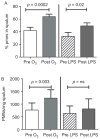Comparative airway inflammatory response of normal volunteers to ozone and lipopolysaccharide challenge
- PMID: 20540623
- PMCID: PMC3162474
- DOI: 10.3109/08958371003610966
Comparative airway inflammatory response of normal volunteers to ozone and lipopolysaccharide challenge
Abstract
Ozone and lipopolysaccharide (LPS) are environmental pollutants with adverse health effects noted in both healthy and asthmatic individuals. The authors and others have shown that inhalation of ozone and LPS both induce airway neutrophilia. Based on these similarities, the authors tested the hypothesis that common biological factors determine response to these two different agents. Fifteen healthy, nonasthmatic volunteers underwent a 0.4 part per million ozone exposure for 2 h while performing intermittent moderate exercise. These same subjects underwent an inhaled LPS challenge with 20,000 LPS units of Clinical Center Reference LPS, with a minimum of 1 month separating these two challenge sessions. Induced sputum was obtained 24 h before and 4-6 h after each exposure session. Sputum was assessed for total and differential cell counts and expression of cell surface proteins as measured by flow cytometry. Sputum supernatants were assayed for cytokine concentration. Both ozone and LPS challenge augmented sputum neutrophils and subjects' responses were significantly correlated (R = .73) with each other. Ozone had greater overall influence on cell surface proteins by modifying both monocytes (CD14, human leukocyte antigen [HLA]-DR, CD11b) and macrophages (CD11b, HLA-DR) versus LPS where CD14 and HLA-DR were modified only on monocytes. However, LPS significantly increased interleukin (IL)-1beta, IL-6, and tumor necrosis factor (TNF)-alpha, with no significant increases seen after ozone challenge. Ozone and LPS exposure in healthy volunteers induce similar neutrophil responses in the airways; however, downstream activation of innate immune responses differ, suggesting that oxidant versus bacterial air pollutants may be mediated by different mechanisms.
Figures





Similar articles
-
Ozone enhances markers of innate immunity and antigen presentation on airway monocytes in healthy individuals.J Allergy Clin Immunol. 2007 Sep;120(3):719-22. doi: 10.1016/j.jaci.2007.05.005. Epub 2007 Jun 21. J Allergy Clin Immunol. 2007. PMID: 17586033 Clinical Trial. No abstract available.
-
Development of an inhaled endotoxin challenge protocol for characterizing evoked cell surface phenotype and genomic responses of airway cells in allergic individuals.Ann Allergy Asthma Immunol. 2008 Mar;100(3):206-15. doi: 10.1016/S1081-1206(10)60444-9. Ann Allergy Asthma Immunol. 2008. PMID: 18426139
-
Effect of inhaled endotoxin on airway and circulating inflammatory cell phagocytosis and CD11b expression in atopic asthmatic subjects.J Allergy Clin Immunol. 2003 Aug;112(2):353-61. doi: 10.1067/mai.2003.1651. J Allergy Clin Immunol. 2003. PMID: 12897742
-
Fluticasone propionate protects against ozone-induced airway inflammation and modified immune cell activation markers in healthy volunteers.Environ Health Perspect. 2008 Jun;116(6):799-805. doi: 10.1289/ehp.10981. Environ Health Perspect. 2008. PMID: 18560537 Free PMC article. Clinical Trial.
-
The role of oxidative stress and innate immunity in O(3) and endotoxin-induced human allergic airway disease.Immunol Rev. 2011 Jul;242(1):91-105. doi: 10.1111/j.1600-065X.2011.01035.x. Immunol Rev. 2011. PMID: 21682740 Review.
Cited by
-
Gamma tocopherol-enriched supplement reduces sputum eosinophilia and endotoxin-induced sputum neutrophilia in volunteers with asthma.J Allergy Clin Immunol. 2018 Apr;141(4):1231-1238.e1. doi: 10.1016/j.jaci.2017.06.029. Epub 2017 Jul 20. J Allergy Clin Immunol. 2018. PMID: 28736267 Free PMC article. Clinical Trial.
-
Exposure to ozone modulates human airway protease/antiprotease balance contributing to increased influenza A infection.PLoS One. 2012;7(4):e35108. doi: 10.1371/journal.pone.0035108. Epub 2012 Apr 9. PLoS One. 2012. PMID: 22496898 Free PMC article.
-
IL-1 receptor antagonist reduces endotoxin-induced airway inflammation in healthy volunteers.J Allergy Clin Immunol. 2015 Feb;135(2):379-85. doi: 10.1016/j.jaci.2014.07.039. Epub 2014 Sep 5. J Allergy Clin Immunol. 2015. PMID: 25195169 Free PMC article. Clinical Trial.
-
Investigating Susceptibility to Diabetes Using Features of the Adipose Tissue in Response to In Utero Polycyclic Aromatic Hydrocarbons Exposure.Diabetes Metab J. 2016 Dec;40(6):494-508. doi: 10.4093/dmj.2016.40.6.494. Epub 2016 Aug 12. Diabetes Metab J. 2016. PMID: 27535646 Free PMC article.
-
Curcumin Attenuates Airway Inflammation and Airway Remolding by Inhibiting NF-κB Signaling and COX-2 in Cigarette Smoke-Induced COPD Mice.Inflammation. 2018 Oct;41(5):1804-1814. doi: 10.1007/s10753-018-0823-6. Inflammation. 2018. PMID: 29961171
References
-
- Alexis NE, Peden DB. Blunting airway eosinophilic inflammation results in a decreased airway neutrophil response to inhaled LPS in patients with atopic asthma: A role for CD14. J Allergy Clin Immunol. 2001;108:577–580. - PubMed
-
- Alexis N, Eldridge M, Reed W, Bromberg P, Peden DB. CD14-dependent airway neutrophil response to inhaled LPS: Role of atopy. J Allergy Clin Immunol. 2001;107:31–35. - PubMed
-
- Alexis NE, Eldridge MW, Peden DB. Effect of inhaled endotoxin on airway and circulating inflammatory cell phagocytosis and CD11b expression in atopic asthmatic subjects. J Allergy Clin Immunol. 2003;112:353–361. - PubMed
-
- Alexis NE, Lay JC, Almond M, Peden DB. Inhalation of low-dose endotoxin favors local T(H)2 response and primes airway phagocytes in vivo. J Allergy Clin Immunol. 2004;114:1325–1331. - PubMed
-
- Alexis NE, Lay JC, Almond M, Bromberg PA, Patel DD, Peden DB. Acute LPS inhalation in healthy volunteers induces dendritic cell maturation in vivo. J Allergy Clin Immunol. 2005;115:345–350. - PubMed
Publication types
MeSH terms
Substances
Grants and funding
LinkOut - more resources
Full Text Sources
Medical
Research Materials
